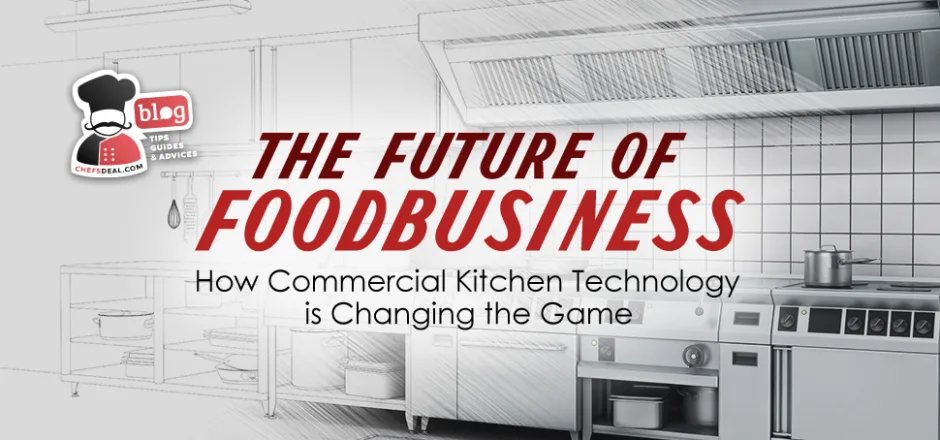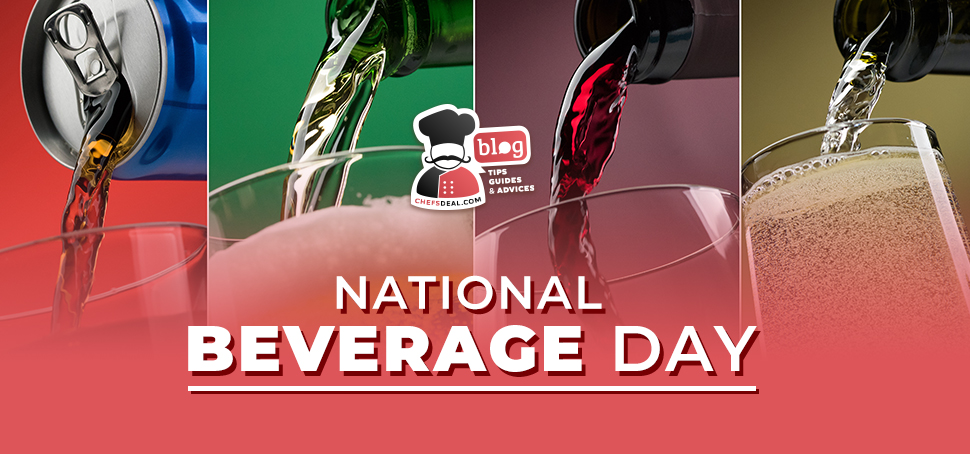Commercial kitchen technology has been transforming how commercial kitchens function, leading to improvements in food and restaurant quality. Technological advancements have affected every aspect of commercial kitchens, providing practicality, flexibility, and efficiency. Due to increasing competition among food service businesses, operations have had to adapt to embrace new technological changes in order to manage food quality and safety, inventory, waste prevention, and equipment maintenance. As technology continues to advance, commercial kitchens are becoming increasingly automated with various inventions.
The Evolution of Commercial Kitchen Technology
Technology started taking place in commercial kitchens with the emergence of computer technology in the 1980s, leading the way for pos systems, digital scales, and display systems in kitchens. Later, commercial kitchen technology began to improve and serve different operations in food service businesses.
IoT, referring to the Internet of Things, is another commercial kitchen technology that is a network of equipment and devices connected to the Internet. It provides many facilities, such as remote controlling devices and automation.
The introduction of robotics and automation in kitchen equipment make the last step in the evolution of commercial kitchen technology. Robotics and automatic kitchen equipment, such as robotic grills, replace the work done manually.
The Latest Innovations in Commercial Kitchen Technology
The impacts of the improving technology can be seen everywhere in a commercial kitchen. From smart equipment to inventory management and payment systems, commercial kitchen technology has been adopted to automate repetitive tasks, reduce staff labor, improve food quality and safety, provide energy savings, and cut labor expenses. Here are some of the latest innovations in commercial kitchen technology.
1. Cooking Equipment
Commercial kitchen technology innovations brought a new perspective to commercial cooking equipment. With the invention of IoT and smart cooking equipment, commercial kitchen technology is meant to meet the growing demand for effectiveness and safety in kitchens. And it does as obvious.
Cook & hold ovens are one of smart ovens with the capability of keeping the food warm until serving after cooking it. Cook-and-hold ovens include presets for several kinds of foods, including specific times and temperatures for each. It only requires choosing the setting, and it will handle the rest. It will cook the food at a determined time and heat and change to holding mode, keeping the food safe and serving temperatures. It decreases energy costs and allows the staff to remotely control and monitor the equipment with an internet connection.
Every second counts in commercial kitchens. This means that in a commercial kitchen, time is a valuable resource that must be used efficiently. Automatic fryers enable the staff to use the time spent controlling the frying process in other tasks, boosting efficiency and producing consistent results. Thanks to smart and automatic controls and timers, it will alert the staff when the cooking is done. Moreover, some automatic fryers have an automatic basket lifting feature that automatically lifts the basket when the food inside is cooked, removing to do it manually or worrying about overcooking.
Multi-function cooking equipment is getting popular in commercial kitchens with the double efficiency they provide. But there are more recent commercial kitchen technologies such as HPP. HPP, referring to high-pressure processing, is a method of preserving food by exposing it to high pressure, which kills hazardous germs while maintaining the food’s flavor and minerals at the same time.
Although sous vide is a very old cooking method, it is a method that has developed with technological developments. It’s another innovative cooking method that consists of cooking food in a vacuum-sealed bag in water that is heated to a specific temperature. This process provides delicate and tender products.
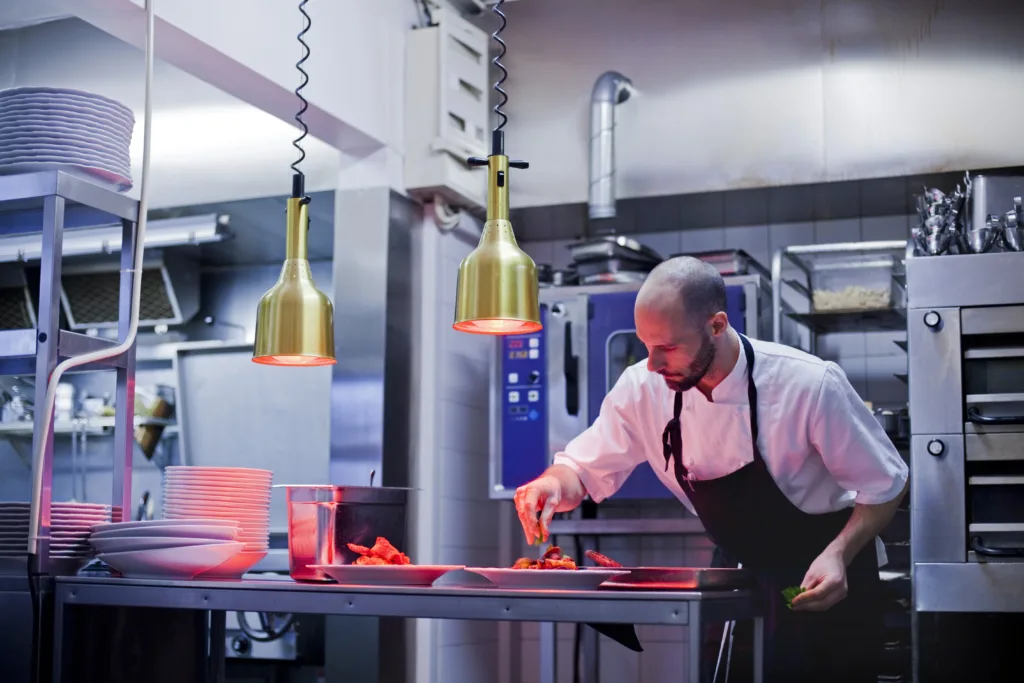
2. Refrigeration Equipment
Several commercial kitchen technologies are used in refrigeration equipment to boost efficiency and lower energy consumption. Noise reduction is one of the commercial kitchen technologies used in commercial refrigerators to reduce the unit’s noise, which can be disruptive for the staff and customers. It can be done in several ways, such as using fewer friction points in units, sound barriers, or vibration-dampening materials.
Magnetic refrigeration is another interesting commercial kitchen technology. The refrigeration works by creating a magnetocaloric effect by exposing a magnetic material, such as iron, to magnetic fields. As a result of the explosion to high and low magnetic fields, the material absorbs and releases heat, producing a cooling effect. It is a more energy-efficient and eco-friendly way of refrigeration, but it is still in the developing process.
3. Dishwashing Equipment
Dishwashing equipment is one of the main components of a commercial kitchen, which has also undergone many technological changes. The latest innovations in dishwashing equipment include cleaning systems with no chemicals. This chemical-free dish-cleaning process is done by either steam or UV light, eliminating the need for cleaning chemicals. Moreover, it increases sustainability and lowers the danger that chemicals may generate.
Another commercial kitchen technology in dishwashing equipment is touchless dishwasher units, ideal for places with strict hygiene and sanitation requirements, such as food processing facilities or healthcare institutions. These units use sensors and automation to regulate the washing process, removing the need for manual intervention and boosting hygiene.
4. Storage Equipment
Robotic systems are one of the latest commercial kitchen technology that utilizes automatic robots to transfer objects in huge storage environments. These robotics eliminate the need for human labor and provide extra speed and accurate inventory management.
The freshly-invented food lockers generate heat to keep the food warm and ready-to-serve and have self-cleaning functions are some of the technological innovations in commercial storage equipment.
5. Robotic Chefs and Kitchen Assistants
Robotics are started to take their places in commercial kitchens. An automated plating system is one of them, which features robotic arms and a conveyor belt, used to plate dishes rapidly. These devices can assist in minimizing waiting times and enhance service speed, which is great for busy hours and high-volume businesses.
AI has entered commercial kitchens after many other fields. AI tells recipes by analyzing ingredients and flavor features using machine learning techniques. It can also develop meals based on different dietary requirements.
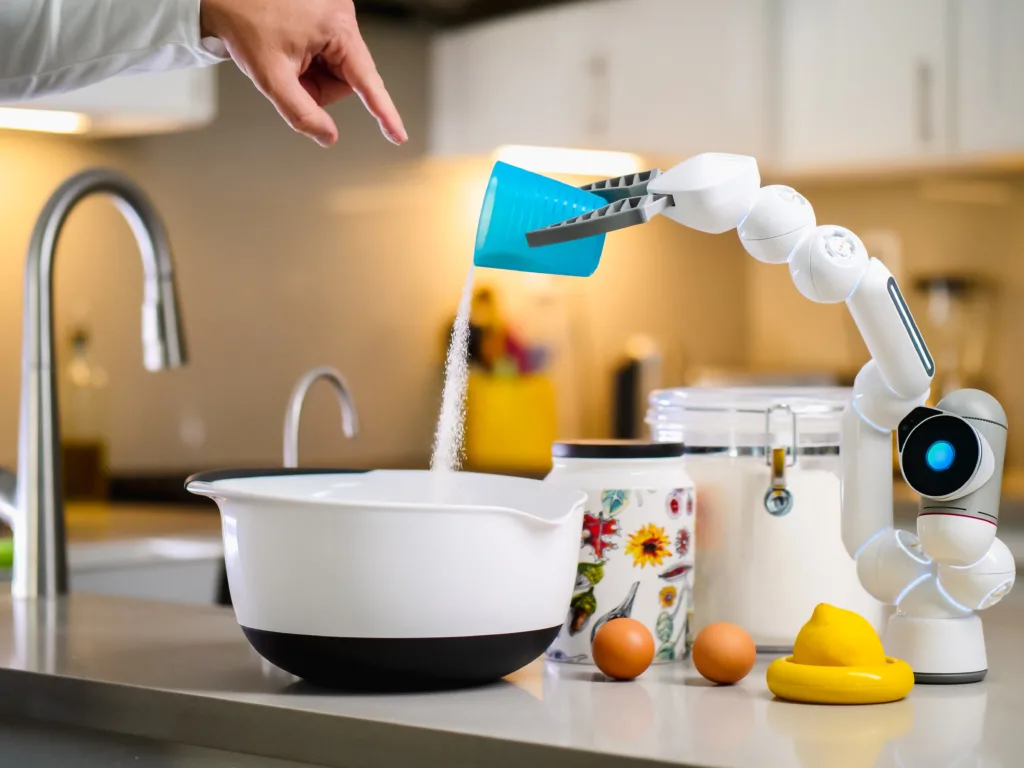
6. Inventory Management and Ordering Systems
Smart shelving is a great inventory management technology that can control inventory. This software can monitor inventory levels and purchase orders when they reach the desired reordering point. This technology removes the need for manual inventory calculation saving a great amount of time and preventing food waste using backtracking. These are all done by commercial kitchen technology, including AI, machine learning, and IoT.
7. Food Preparation Equipment
As the foodservice industry evolves and becomes more advanced, so the technologies and equipment used for preparation. The latest food prep equipment offers increased efficiency, precision, and consistency in preparing ingredients and dishes. Manufacturers are constantly developing new and specialized machines, such as vegetable cutters, meat grinders, and dough sheeters, to cater to the unique needs of commercial kitchens.
With the increasing importance of safety and sanitation in the foodservice business, especially after the COVID-19 pandemic, food prep equipment is also designed to reduce the risk of cross-contamination and minimize handling raw ingredients. The latest technologies are continually being integrated into commercial food prep equipment, such as touchscreens and automated settings, to further streamline and simplify the food prep process.
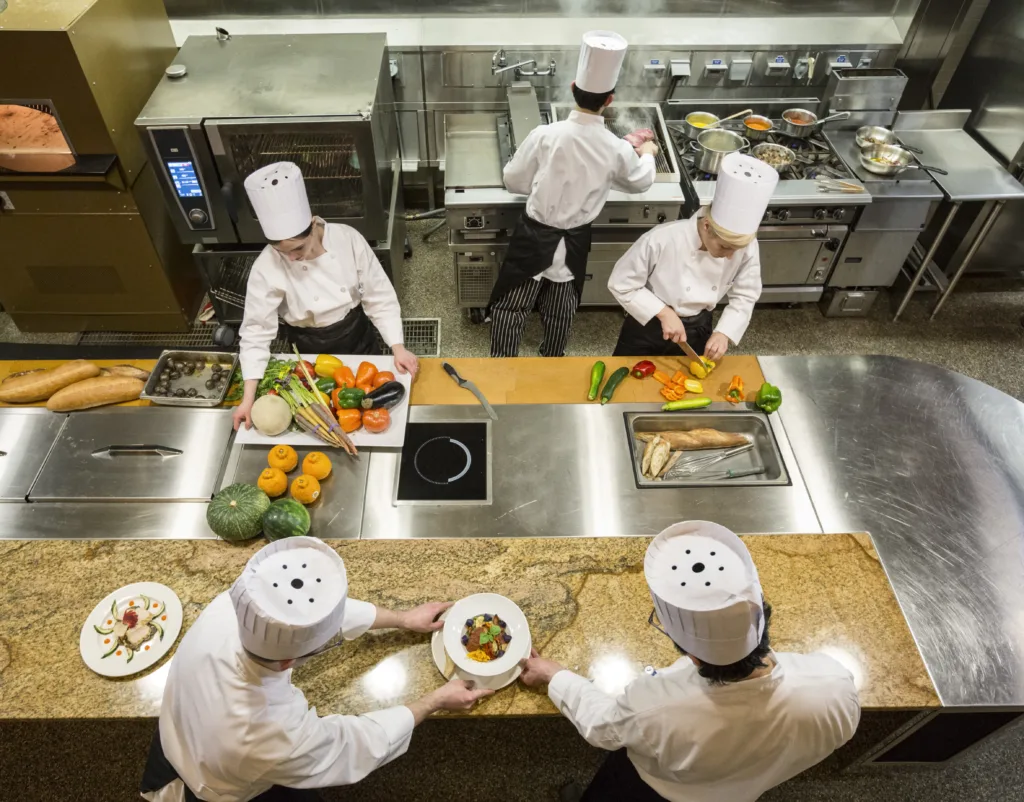
8. Waste Reduction and Sustainability Efforts
Food waste has become one of the common problems of all food service establishments. There are several practices to avoid that and support sustainability, and technology has something for it. Smart energy management technology helps commercial kitchens decrease food waste and improve energy consumption by monitoring energy use using sensors and machine learning algorithms and reducing waste by modifying settings.
Water conservation technologies are another important commercial kitchen technology. Water conservation technologies can be seen in water-efficient dishwashers or low-flow faucets, reducing water usage in commercial kitchens.
9. Online Ordering and Delivery Platforms
Commercial kitchen technology for online ordering and delivery platforms had made progress mostly during the global pandemic Covid-19 when physical contact was limited and quarantine began. People preferred online orders during and after the quarantine, so mobile order and delivery apps became popular. Mobile order and delivery apps provide easy choosing and ordering food from mobile phones, providing simplicity and quickness for food service businesses as well.
One of the latest innovations in delivery is drones. Drones are automated self-flying vehicles that can be used for various tasks. They can be piloted remotely by people or a computer. You may have heard about drone delivery earlier, which couldn’t advance more than test driving. But actually, some establishments have used drones for delivery for a long time, such as in Iceland. Removing human labor and the necessity for other vehicles, drones could be the future of food delivery.
10. In-House Ordering and Payment Systems
Ordering systems have come to another level from the old writing-down systems. New technological ordering systems provide staff to send the order directly to a monitor or tablet in the kitchen through a computer system. This system lessens the interaction between the wait and kitchen staff and accelerates the process greatly.
Mobile payment systems are becoming popular daily, mostly because people prefer credit cards or digital wallets over cash and less interaction and physical contact between staff and customers. Paying through mobile apps or NFC technology is more comfortable and quicker, making it preferable.
11. Customer Data and Analytics
IoT can be used in commercial kitchens to collect real-time data and other tasks. IoT sensors can collect data on equipment utilization, kitchen operations, and inventory and use this information to enhance and improve client experiences and kitchen operations.
One of the versatile usage areas of AI is to use it to identify consumer behaviors, order preferences, trends, and peak hours, to use them for marketing and menu optimization.
12. Predictive Analytics for Inventory Management
Predictive analytics is a great way for inventory management by collecting inventory-related data and making forecasts about future inventory needs using these data, weather forecasts, and trends to improve and optimize inventory needs and reduce food waste. The quantity and frequency of using food, supply times, and consumer demands are some of the data used for inventory management. This guarantees that the proper components are available at the right time, eliminating overstocking and food spoiling.
13. Real-Time Data for Order Tracking and Efficiency Analysis
Kitchen display systems are digital display screens providing order information in real-time, such as type of order, time since order, and table number. They can be linked to pos systems to offer data on order volume and average waiting times. Kitchen managers can track real-time order volume and efficiency via mobile apps from anywhere they want. And they can use this data to optimize kitchen operations and control staff levels.
14. Customer Feedback and Reviews for Menu Optimization
Analyzing customer reviews and feedback greatly helps optimize the menu and fix insufficiencies. There are several ways to achieve it, such as analyzing online reviews and feedback through many sites and mobile apps. Customer satisfaction surveys are another way to collect customer feedback to make improvements. Lastly, social media could be one of the easiest and most efficient ways to get customer feedback. Considering all the collected data from customer feedback and reviews and making changes according to customer demands will highly improve and boost sales and customer satisfaction rates.
Overcoming Challenges and Maximizing Benefits of Adopting New Technology
Commercial kitchen technology provides various benefits, including increased productivity, efficiency, and customer satisfaction. Yet, there are some certain points to overcome the obstacles and maximize the benefits of adopting new technology, such as selecting the right technology for your business, providing adequate staff training, and planning a strategy to adopt the changes.
Not all technology can be efficient for your business or assist you in achieving your company goals, so understanding how commercial kitchen technology can affect your operation will help you choose the proper technology.
Factors to Consider When Choosing a Commercial Kitchen Technology
There are some points to consider before choosing commercial kitchen technology. Investing in commercial kitchen technology will benefit many processes, but making these considerations will help you decide if it will be efficient for you and allow you to use them in the best way possible.
1. Costs and Budgeting for Technology Investments
If you plan for technological investments, considering your budget and possible costs will guide you in choosing the most suitable and efficient ones for your business. Hardware, software, installation, and training staff are some of the upfront expenditures, and licensing fees, upgrades, and maintenance should be considered in the long-term budget.
Scalability and flexibility of the technology are critical to consider since the technology should be able to expand with your organization without having a major revamp in the future. Considering all these factors will help you budget properly and benefit from the technology in the long run.
2. Training and Onboarding Staff for Technology Implementation
After choosing the right technology for your business, now is the time to use it efficiently. Training your staff properly about how to use the technology is essential since it will affect the benefits the technology brings. Selecting the key staff members who will use the new investments and focusing on their training first will make them learn the technology better so they can train the other staff members. Creating a training plan including what staff needs to know and which resources are required will ensure the team learns everything needed and can completely use it.
3. Energy Efficiency
Commercial kitchen technology’s effectiveness and productivity are undeniable; how about energy efficiency?
There are various developments for adopting energy efficiency in kitchen technologies, and energy-efficient equipment is getting popular. Smart controls optimize energy use by shutting off the equipment that is not in use or altering temperature settings using programmable thermostats and occupancy sensors. Insulation and ventilation systems are other practices to establish energy efficiency and help achieve sustainability.
4. Maintenance
As with every investment, technological investments and programs require maintenance to continue operating properly. The software and programs require updates as equipment needs regular cleaning to function appropriately. Keeping them up to date helps prevent security flaws and ensures the equipment works at peak performance.
Additionally, regular equipment inspections may help uncover possible issues before they become bigger problems, such as leaks, wear and tear.
5. Security and Data Privacy Concerns with Digital Systems
Commercial kitchen technology, like other digital systems, brings security and privacy concerns and problems. Some of the most serious issues are the possibility of data breaches and cyberattacks that may cause the loss of sensitive information, such as financial and customer information. Using strong safety measures and antivirus software and informing the staff about suspicious emails and links are crucial to prevent these problems.
FAQs About Commercial Kitchen Technology
What is commercial kitchen technology?
Commercial kitchen technology is using technological innovations in commercial kitchen equipment to provide higher performance and efficiency and ensure food safety and quality.
How can commercial kitchen technology benefit my business?
Commercial kitchen technology boosts production and efficiency while providing food safety and quality. Using smart equipment, remote controls, and other new technologies lowers costs and labor and provides more eco-friendly machines.
What are the types of commercial kitchen technology?
Commercial kitchen technology can be adopted in many ways and investments, such as commercial kitchen equipment from cooking to refrigeration, pos and KDS systems, online order and delivery platforms, and systems for food safety and inventory.
What factors should I consider when choosing commercial kitchen technology?
To make the best use of commercial kitchen technology, you can consider your business’s main goal and what equipment would benefit it, your budget, a training plan for your staff, and maintenance requirements.
How can I maintain my commercial kitchen technology?
Keeping the software updated, arranging a regular cleaning plan, and regularly inspecting equipment will reduce maintenance costs and longer equipment lives.
Conclusion
Commercial kitchen technology has evolved and revolutionized the way of restaurants and other foodservice businesses. From smart ovens and stoves to robotic chefs and inventory management systems, the latest innovations in commercial technology offer numerous benefits, including increased efficiency, flexibility, reduced waste, safety in kitchen operations, and improved customer experience.
Commercial kitchen technology is the future of the food business with day-to-day renewing investments. However, when choosing and implementing new technology, companies must also consider some factors, such as costs, training, energy efficiency, maintenance, and security. By carefully evaluating these factors and maximizing the benefits of kitchen technology, businesses can stay ahead of the competition and thrive in today’s fast-paced, technology, and data-driven marketplace. We recommend investing in the latest technology to streamline operations, improve customer satisfaction, and drive success in the foodservice industry.

